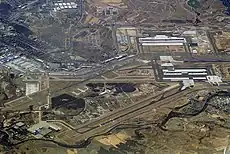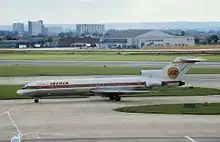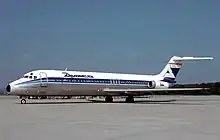 Overview of Madrid–Barajas Airport, the site of the disaster. | |
| Accident | |
|---|---|
| Date | 7 December 1983 |
| Summary | Runway incursion due to inadequate signs and markings |
| Site | Madrid–Barajas Airport 40°28′11″N 3°33′46″W / 40.46972°N 3.56278°W |
| Total fatalities | 93 |
| Total injuries | At least 30 (all on the Boeing 727)[1] |
| Total survivors | 42 |
| First aircraft | |
 EC-CFJ, the Boeing 727 involved in the collision, seen at London Heathrow Airport, in 1981 | |
| Type | Boeing 727-256 |
| Name | Jumila |
| Operator | Iberia |
| IATA flight No. | IB350 |
| ICAO flight No. | IBE350 |
| Call sign | IBERIA 350 |
| Registration | EC-CFJ |
| Flight origin | Madrid–Barajas Airport (MAD/LEMD) |
| Destination | Roma–Fiumicino Airport (FCO/LIRF) |
| Occupants | 93 |
| Passengers | 84 |
| Crew | 9 |
| Fatalities | 51 |
| Injuries | At least 30[1] |
| Survivors | 42 |
| Second aircraft | |
 EC-CGS, the DC-9 involved in the collision, seen at Basel Mulhouse Freiburg Airport, in 1980 | |
| Type | McDonnell Douglas DC-9-32 |
| Name | Vasco Núñez de Balboa |
| Operator | Aviaco |
| IATA flight No. | AO134 |
| ICAO flight No. | AYC134 |
| Call sign | AVIACO 134 |
| Registration | EC-CGS |
| Flight origin | Madrid–Barajas Airport (MAD/LEMD) |
| Destination | Santander Airport (SDR/LEXJ) |
| Occupants | 42 |
| Passengers | 37 |
| Crew | 5 |
| Fatalities | 42 |
| Injuries | 0 |
| Survivors | 0 |
The Madrid runway disaster was on 7 December 1983 when a departing Iberia Boeing 727 struck an Aviaco McDonnell Douglas DC-9 at Madrid-Barajas Airport, causing the deaths of 93 passengers and crew.
Passengers and crew
There were 84 passengers and 9 crew members aboard Iberia Flight 350. The captain was Carlos Lopez Barranco, 43, who had accumulated 8,860 flight hours as a pilot, with 1,919 hours on the 727. The second-in-command was First Officer Juan José Ochoa, 41, with 3,474 flight hours, 2,840 of which were on the 727. They were accompanied by second officer and flight engineer Luis Luengo, 37, who had 7,211 flight hours of experience.
There were 37 passengers and 5 crew members aboard Aviaco Flight 134. Commanding the flight was the experienced Captain Augusto Almoguera, 54, who had accumulated 13,442 flight hours of experience, 6,600 on the DC-9. Captain Almoguera knew Captain Lopez Barranco, who had been his instructor in air training courses at the Jerez de la Frontera Base. He was accompanied by the first officer and co-pilot José María Gibernau, 39, with 10,322 flight hours, 3,655 of which were on the DC-9.
Crash
On 7 December 1983, a Boeing 727 of Iberia (Spain's state airline) registered EC-CFJ, operating Iberia Flight 350, a scheduled flight to Rome's Leonardo da Vinci–Fiumicino Airport, was cleared for take-off from Madrid-Barajas Airport's Runway 01 in conditions of thick fog.[2][3] At the same time, a DC-9 of Aviaco registered EC-CGS, operating Aviaco Flight 134, was taxiing to the end of the same runway for take-off bound for Santander Airport.[4] As the Boeing 727 rolled along the runway, the crew of the DC-9 accidentally made a wrong turn in the fog and taxied their aircraft onto the runway, into the path of the 727. The crew of the 727 saw the DC-9 and attempted to avoid the collision by rotating their aircraft for lift-off, however the 727 had not reached flying speed and its rear fuselage struck the DC-9.[3][4] Both aircraft caught fire and were destroyed; all 42 people on board the DC-9 were killed, while 51 (50 passengers, one crew member) of the 93 on board the Boeing 727 were killed.[2][5]
Notable victims
Among those killed were Mexican actress Fanny Cano (aboard the Iberia 727) and South African pianist Marc Raubenheimer (aboard the Aviaco DC-9).[6]
Investigation
Investigators found that the Boeing 727 and DC-9 had collided due to the poor visibility at the airport, as well as inadequate signs and markings, which led to the DC-9 entering the runway without clearance as the Boeing 727 was taking off.[2]
See also
- 1990 Wayne County Airport runway collision, another fatal runway incursion involving a Boeing 727 and a DC-9.
- 1983 Anchorage runway collision, another December 1983 runway collision involving incorrect taxiing in dense fog.
- Linate Airport disaster, a runway collision in Italy killing 118 people and also involving incorrect taxiing in dense fog.
- Tenerife airport disaster, another collision of two 747 aircraft at a Spanish airport in fog and the worst aircraft accident in history in terms of loss-of-life, with 583 lives lost.
References
- 1 2 "Final report of the accident in English" (PDF). Archived (PDF) from the original on 24 September 2015. Retrieved 12 May 2020.
- 1 2 3 Ranter, Harro. "ASN Aircraft accident Boeing 727-256 EC-CFJ Madrid-Barajas Airport (MAD)". aviation-safety.net. Aviation Safety Network. Retrieved 11 February 2020.
- 1 2 "Madrid Cleared?", Flight International, 17 December 1983, p. 1582 (online archive version), retrieved 17 April 2012
- 1 2 Ranter, Harro. "ASN Aircraft accident McDonnell Douglas DC-9-32 EC-CGS Madrid-Barajas Airport (MAD)". aviation-safety.net. Aviation Safety Network. Retrieved 11 February 2020.
- ↑ "Madrid airport crash death toll set at 92". The Calgary Herald. Reuters. Retrieved 11 February 2020 – via Google News.
- ↑ "30 años de la pérdida de José Mª Cagigal en el siniestro de Barajas y del que se libró Ballesteros" [30 years after the loss of José Mª Cagigal in the Barajas incident and from which Ballesteros was spared]. Mundo Deportivo (in Spanish). Retrieved 10 January 2020.
Tal día como hoy de 1983, el aeropuerto de Madrid-Barajas registraba su accidente más mortal hasta el momento, con un total de 93 muertos. La desgracia quiso que entre esas vítimas se encontrase José María Cagigal y dos colaboradores. [English: On this day, as of 1983, the Madrid-Barajas airport recorded its deadliest accident so far, with a total of 93 dead. Misfortune wanted José María Cagigal and two collaborators to be among those victims.]
External links
- Final report (Archive)
- Final report (Archive) (in Spanish)
- Iberia Flight 350 at AirDisaster.com[usurped] (Archive[usurped])
- Aviaco Flight 134 at AirDisaster.com[usurped] (Archive[usurped])